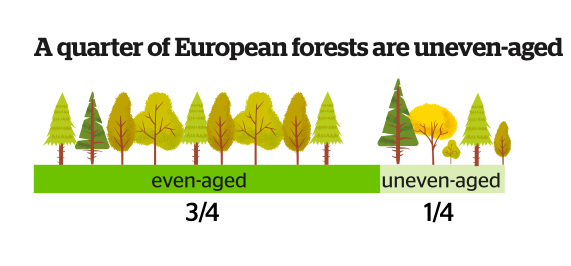Forest and Nature
The state of nature in forest areasIntroduction
Forests are important for nature. They provide typical habitat for many plant and animal species. Many species are adapted and bound to the forest environment like woodpeckers, blueberries, wood insects like the European stag beetle (Lucanus cervus) and wood fungi. This biodiversity is important for the life cycle processes in the forests. Therefore nature and biodiversity are protected by Natura 2000, a network of nature areas throughout Europe, and regulations such as the bird and habitat directives. Species and habitats are monitored to evaluate the quality of sites and effects of management and policy strategies. Here information is presented on the state of nature in forest areas.
Conservation status and trends of habitats and species
%
Forests are the dominant habitat type in Europe, 35% (0.5 million km2) of the protected areas is forest.
%
A vast majority of the forest habitat assessments (75%) have a bad or poor conservation status and 20% (100,000 km2) are in need of restoration.
%
The trend in the status of forest birds is stable for almost 40 years, however specific species are detoriating (17%) and others are improving (34%).
%
A vast majority of the forest habitat assessments (75%) have a bad or poor conservation status and 20% (100,000 km2) are in need of restoration.

Deadwood: An important indicator for biodiversity
Forest deadwood is a structural indicator that measures habitat quality. Deadwood in forests provides an important source of habitat, shelter and food for many rare and threatened species, such as insects, fungi and lichens, birds, bats and other mammals. Deadwood is often removed in commercial forests and even in protected areas, and this practice is now monitored across the EU.
Deadwood volume per hectare and proportion of deadwood volume to growing stock, by country, 2015.
- Slovakia
- Czech Republic
- Switzerland
- Latvia
- France
- Lithuania
- Austria
- Germany
- Turkey
- Estonia
- Netherlands
Pressures
Intensive land management, land use change and climate change impacts are important pressures that threaten nature values of forests. Also forest management practices itself put pressure on forests. In Europe almost all natural forest is replaced by managed forest. The structure and diversity of forests are affected by the removal of dead and dying trees, clear-cutting, removal of old trees and reduction of old-growing forests.

About three-quarters of forests in Europe are even-aged, of which about 64% are beyond the regeneration phase and have not yet reached the mature phase. Nearly a quarter of European forests are uneven-aged.
